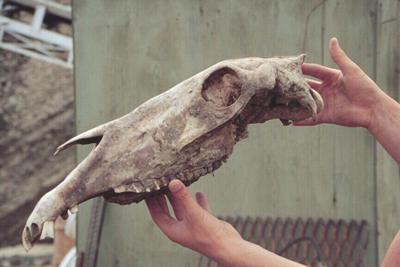University of Southampton archaeologist helps sequence 700,000 year old horse genome

Scientists at the Centre for GeoGenetics at the Natural History Museum of Denmark (University of Copenhagen) have sequenced the oldest genome to date from a prehistoric creature – setting a new world record.
Leading an international team, including University of Southampton archaeologist Dr Jacobo Weinstock, the Copenhagen researchers have sequenced and analysed short pieces of DNA molecules preserved in bone-remnants from a horse kept frozen in the permafrost of Yukon, Canada for the last 700,000 years. By tracking the genomic changes that transformed prehistoric wild horses into domestic breeds, the researchers have revealed the genetic make-up of modern horses in unprecedented detail. These spectacular results have now been published in the international scientific journal Nature: http://www.nature.com/nature/journal/vaop/ncurrent/full/nature12263.html
Southampton’s Dr Jacobo Weinstock took part in the original expedition to Yukon in 2003, when the horse bone was recovered and has been involved in the project since. He extracted DNA and sequenced part of the specimen’s genome as an independent replication of the results obtained by the Copenhagen team.
Jacobo comments: “Extracting and sequencing DNA from ancient organisms is not straightforward; contamination with extraneous DNA is always a potential problem. Therefore, an independent replication of the results in a different laboratory is essential to validate the results, especially in the case of exceptional specimens such as the horse from Yukon. The perfect match between both sequences, in addition to the phylogenetic position of the ancient horse outside the diversity of any horse ever sequenced, provided clear evidence that the data was real.”
DNA molecules can survive in fossils well after an organism dies. Not as whole chromosomes, but as short pieces that can be assembled back together, like a puzzle. Sometimes enough molecules survive so that the full genome sequence of extinct species can be resurrected.
Over recent years the full genome sequence of a few ancient humans and archaic hominins has been characterised, but none have dated back to before 70,000 years ago. However, Dr Ludovic Orlando and Professor Eske Willerslev from the Centre for GeoGenetics have achieved a new DNA-record. The two researchers, in collaboration with Danish and international colleagues, have now been able to track major genomic changes of the horse lineage over the last 700,000 years of evolution.
Professor Willerslev says: “The results of the studies and the applied techniques open up new doors for the exploration of prehistoric living creatures. Now with genomics and proteomics, we can reach ten times further back in time compared to before. New knowledge about the horse’s evolutionary history has been added – a history which is considered as a classical example in evolutionary biology and a topic which is taught in high schools and universities.”
By comparing the genome in the 700,000 year old horse with the genome of a 43,000 year old horse, six present day horses and a donkey, the researchers could estimate how fast mutations accumulate through time and calibrate a genome-wide mutation rate. This revealed that the last common ancestor of all modern equids lived about 4.0-4.5 million years ago. Therefore, the evolutionary radiation underlying the origin of horses, donkeys and zebras reaches back in time twice as long as previously thought. Additionally, this new clock revealed multiple episodes of severe demographic fluctuation in horse history, in phase with major climatic changes such as the Last Glacial Maximum, some 20,000 years ago.
The world’s only wild horse
The results also bring a happy end to a long discussion about the so-called Przewalski’s horse from the Mongolian steppes. This horse population was discovered by the Western world in the second-half of the nineteenth century and rapidly became threatened. It almost became extinct in the wild by the 1970s, but has survived until now following massive conservation efforts.
The evolutionary origin of this horse, which shows striking physical differences compared to domesticated horses, as well as an extra-pair of chromosomes, remained a mystery. The researchers have now revealed that the Przewalski’s horse population became isolated from the lineage, leading to present day domesticated horses, about 50,000 years ago. As the scientists could detect similar levels of genetic diversity within the Przewalski’s horse genome than in the genomes of several domestic breeds, this suggests that the Przewalski’s horses are likely genetically viable and therefore worthy of conservation efforts.
This major scientific advance has been made possible through the collaboration of researchers from Denmark, China, Canada, USA, Switzerland, UK, Norway, France, Sweden and Saudi Arabia and with financial support from the Danish National Research Foundation.
